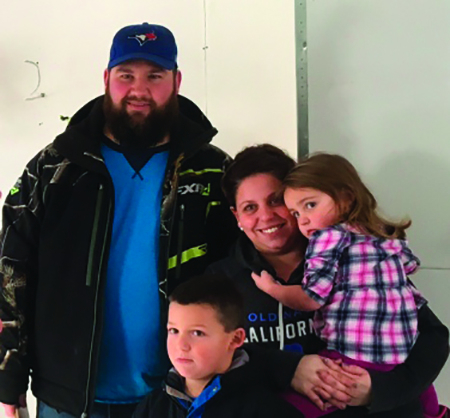Partnering with Habitat allowed Amanda’s family to move closer to their roots

Having just arrived back from this semester’s parent-teacher meetings, Amanda sits in the kitchen of her new Habitat for Humanity home on Tobique First Nation in New Brunswick. Her youngest, Miyah, tugs at her and points up to the ceiling, at one of the balloons which managed to escape from her brother’s birthday party last week and has been taking up residence in a ceiling corner since then. Miyah won’t let her mom get rid of it. Her eight-year-old son Colton is outside, playing ball hockey. Over the clatter of small feet running in and out, and doors opening and shutting, Amanda laughs and says there are always kids from the neighbourhood visiting.
“The kitchen is my favourite part of our new home. We love having family over – I think we’ve had people over almost every single weekend since we moved in,” says Amanda.
Amanda had first moved away from Tobique First Nation to study and work. But now, with two young children, it was important to her that she raise them in her home community. Amanda wanted her children to connect with their heritage and their family on Tobique First Nation where she was born and raised, and where most of her family still live.
No new homes had been built in Tobique First Nation in 13 years
But no houses had been built on Tobique First Nation for 13 years, exacerbating the situation of overcrowding where multi-generations of family often live in one home. Across Canada, both on and off reserve, Indigenous peoples are faced with severe housing shortages with many living in overcrowded, inadequate and unsafe housing.
When they first moved back, Amanda and Phil lived with her mother for two months before finally finding a small, two-bedroom rental apartment outside of Tobique First Nation for the four of them. Although it was slightly less crowded than living with her mother, it was still small and cramped. She didn’t feel safe there and hoped it would be a temporary situation. However, with no additional housing being built on the reserve, she wasn’t sure what their future held. Her dreams of building a new life for themselves and their children in her home community were on very rocky ground.
“After I saw a poster that Habitat Fredericton was building a home
here and was looking for people to apply, I filled out the forms so
quickly. And then I hoped. And I prayed and prayed and prayed that we
would get this opportunity,” says Amanda.
Moving closer to home
Now, Amanda and her family are busy settling into their new Habitat home, most of which they primed and painted themselves as part of their 500 volunteer hours.
Their new Habitat home is even around the corner from her mother, and Colton, who had been struggling while in school in Fredericton, is now thriving at the local school on this small reserve of almost 2,500 people. Amanda’s family is demonstrating how Habitat’s model of affordable homeownership and partnership can be an important part of the solution to the severe housing crisis in Indigenous communities across Canada.
At her son’s request, Amanda is considering a garden to grow fresh vegetables.
“Last week at the grocery store, he kept pointing out all the things he thought we could grow for ourselves. He asked if he could plant an apple tree. I think that’s a great idea. I remember seeing the trees by my mom’s house grow bigger as I grew up. And now when I visit her, I see these big trees and remember how small they were when I was young, and what a long way my family and I have had to go to come back home. I want my son to have that too – and be reminded every time he sees that apple tree that this is home for him too.”


